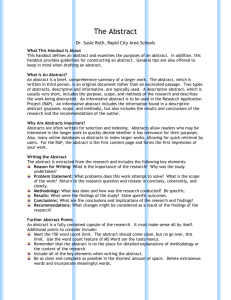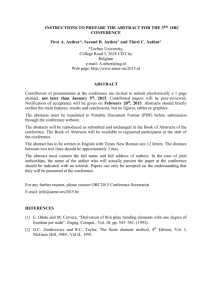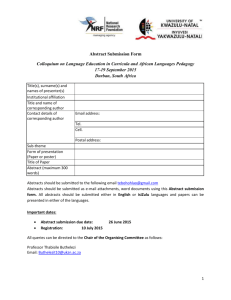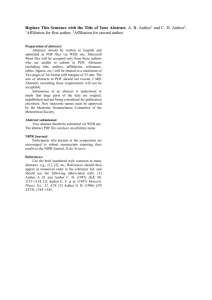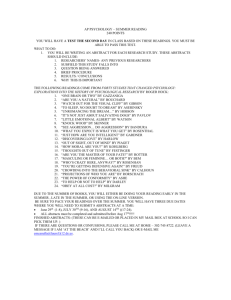Abstracts - Binus Repository
advertisement
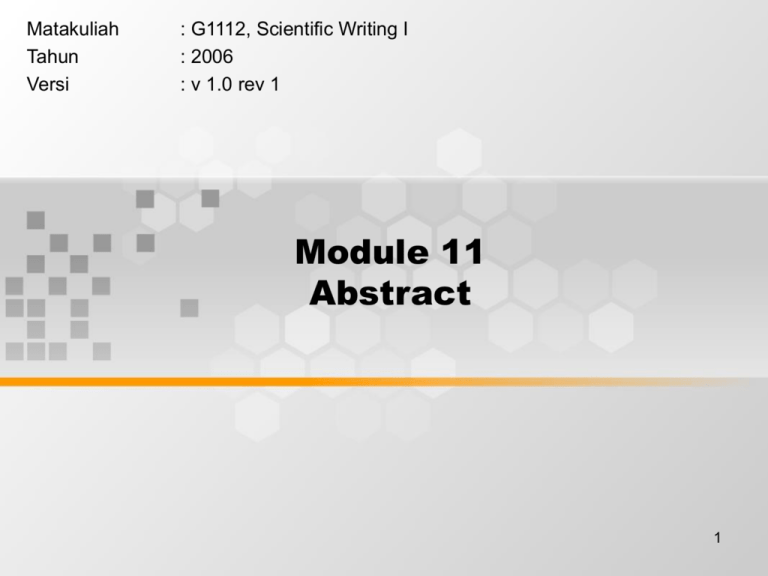
Matakuliah Tahun Versi : G1112, Scientific Writing I : 2006 : v 1.0 rev 1 Module 11 Abstract 1 What’s inside 1. What is an abstract 2. How to create an abstract in scientific paper 2 What is an abstract? • An abstract is a short informative or descriptive summary of a longer report. • It is written after the report is completed, although it is intended to be read first. • In a technical report, the abstract appears on a separate page after the table of contents and list of illustrations. • In an essay written for a humanities class, it most likely should appear on a separate page, just after the title page and therefore just before the essay itself. 3 What is an abstract? Abstracts are important because they give a first impression of the document that follows, letting readers decide whether to continue reading and showing them what to look for if they do. Though some abstracts only list the contents of the document, the most useful abstracts tell the reader more. An abstract should represent as much as possible of the quantitative and qualitative information in the document, and also reflect its reasoning. http://www.utoronto.ca/writing/abstract.html 4 What is an abstract? Typically, an informative abstract answers these questions in about 100-250 words: • • • • Why did you do this study or project? What did you do, and how? What did you find? What do your findings mean? If the paper is about a new method or apparatus the last two questions might be changed to • What are the advantages (of the method or apparatus)? • How well does it work? http://www.utoronto.ca/writing/abstract.html 5 Definition There are two distinct types of abstracts: • A DESCRIPTIVE abstract merely identifies the areas to be covered in the report. It is an extended statement of purpose or scope. Such an abstract is only useful for a very long report, because it demonstrates only the paper's organization, not its content. • An INFORMATIVE abstract summarizes the entire report and gives the reader an overview of the facts that will be laid out in detail in the paper itself. It is rarely longer than one page and should never exceed more than 10% of the length of the entire report; otherwise it defeats its own purpose. http://www.gmu.edu/departments/writingcenter/handouts/abstract.html 6 Characteristics • Descriptive Abstracts – – – – – • tell readers what information the report, article, or paper contains. include the purpose, methods, and scope of the report, article, or paper. do not provide results, conclusions, or recommendations. are always very short, usually under 100 words. introduce the subject to readers, who must then read the report, article, or paper to find out the author's results, conclusions, or recommendations. Informative Abstracts – – – – – communicate specific information from the report, article, or paper. include the purpose, methods, and scope of the report, article, or paper. provide the report, article, or paper's results, conclusions, and recommendations. are short -- from a paragraph to a page or two, depending upon the length of the original work being abstracted. Usually informative abstracts are 10% or less of the length of the original piece. allow readers to decide whether they want to read the report, article, or paper. 7 Functions Several potential uses for abstracts: • An executive preparing a comprehensive report might ask her assistant to abstract articles from different levels of periodicals to provide information quickly and to help her decide whether to read the complete articles. • A professional might read the abstract accompanying a journal article to decide if it is worth her time to read the full article. • Libraries subscribe to abstracting journals and series (including Dissertation Abstracts International) to provide an overview of content. • Certain congressional and association newsletters provide abstracts of newspaper articles that pertain to issues relevant to their memberships. http://www.gmu.edu/departments/writingcenter/handouts/abstract.html 8 Qualities of a Good Abstract An effective abstract has the following qualities: • uses one or more well developed paragraphs: these are unified, coherent, concise, and able to stand alone. • uses an introduction/body/conclusion structure which presents the article, paper, or report's purpose, results, conclusions, and recommendations in that order. • follows strictly the chronology of the article, paper, or report. • provides logical connections (or transitions) between the information included. • adds no new information, but simply summarizes the report. • is understandable to a wide audience. • oftentimes uses passive verbs to downplay the author and emphasize the information. Check with your teacher if you're unsure whether or not to use passive voice. http://leo.stcloudstate.edu/bizwrite/abstracts.html 9 Steps for Writing Effective Abstracts • Reread the article, paper, or report with the goal of abstracting in mind. – Look specifically for these main parts of the article, paper, or report: purpose, methods, scope, results, conclusions, and recommendation. – Use the headings, outline heads, and table of contents as a guide to writing your abstract. – If you're writing an abstract about another person's article, paper, or report, the introduction and the summary are good places to begin. These areas generally cover what the article emphasizes. • After you've finished rereading the article, paper, or report, write a rough draft without looking back at what you're abstracting. – Don't merely copy key sentences from the article, paper, or report: you'll put in too much or too little information. – Don't rely on the way material was phrased in the article, paper, or report: summarize information in a new way. • Revise your rough draft to – – – – – – • correct weaknesses in organization. improve transitions from point to point. drop unnecessary information. add important information you left out. eliminate wordiness. fix errors in grammar, spelling, and punctuation. Print your final copy and read it again to catch any glitches that you find. 10 Other points Here are some other points to keep in mind about abstracts: • • • • • • An abstract will nearly always be read along with the title, so do not repeat or rephrase the title. It will likely be read without the rest of the document, however, so make it complete enough to stand on its own. Your readers expect you to summarize your conclusions as well as your purpose, methods, and main findings. Emphasize the different points in proportion to the emphasis they receive in the body of the document. Do not refer in the abstract to information that is not in the document. Avoid using I or we, but choose active verbs instead of passive when possible (the study tested rather than it was tested by the study). Avoid if possible avoid trade names, acronyms, abbreviations, or symbols. You would need to explain them, and that takes too much room. Use key words from the document. (For published work, the abstract is "mined" for the words used to index the material--thus making it more likely someone will cite your article.) http://www.utoronto.ca/writing/abstract.html 11 Example SAMPLE ABSTRACT Focus : Achieving Quality in Education: Strategies for Chang Topic : Assessment Procedures – theory and practice Title : STIP - The Speed of Tactile Information Processing - a new assessment tool for children and young people who are blind Abstract: During a period of four years, a new psychological assessment tool has been developed to use with blind children between the ages of 5 and 17 in the UK. Based on the sighted version of Speed of Information Processing Test of the British Ability Scales and the American version, the Differential Ability Scales, it aims to give an accurate way of assessing the speed at which blind pupils can process tactile information, for example a brailled text. Results can be used to compare a blind pupil with other blind pupils and to make comparisons of improvements in ability. The research also draws upon the differences of reading speeds between fully sighted and blind pupils The paper will explain the rationale behind the development of the two parts of the test and then take delegates through the testing and scoring. Some of the difficulties of standardising a new assessment tool for use with a low incidence population will also be examined. It will finally look at how the information can be used within the profile of a child or young person who is blind. 12 Example Badly Written: • This experiment will determine what will make enzymes effective and what will make them ineffective. We tested different samples of enzymes in a spectrophotometer and recorded their absorption rates. Six samples were placed in the spectrophotometer but two contained no enzyme; these acted as blanks for the other samples. The four remaining samples contained Catecholase ranging from 0.5 ml to 1.75 m. The second half of the experiment contained four test tubes with a constant amount of Catecholase, but the pH levels ranged from four to eight. It was found that if the enzyme was present in large amounts, then the absorption rate was high, and if the pH level ranged from 6 to eight then the absorption rate was high. Therefore it can be said that enzymes work well in neutral pH levels and in large amounts. 13 Example Well-Written • Sample 2: This experiment was performed to determine the factors that positively influence enzyme reaction rates in cellular activities since some enzymes seem to be more effective than others. Catecholase enzyme activity was measured through its absorption rate in a spectrophotometer, using light with a wavelength of 540 nm. We compared the absorbance rates in samples with varying enzyme concentrations and a constant pH of 7, and with samples with constant enzyme concentration and varying pH levels. The samples with the highest enzyme concentration had the greatest absorption rate of 95 percent compared to the sample with the lowest concentration and an absorption rate of 24 percent. This suggests that a higher concentration of enzymes leads to a greater product production rate. The samples with a pH between six and eight had the greatest absorption rate of 70 percent compared to an absorption rate of 15 percent with a pH of 4; this suggests that Catecholase is most effective in a neutral pH ranging from six to eight. 14 15 16 17 18 19

